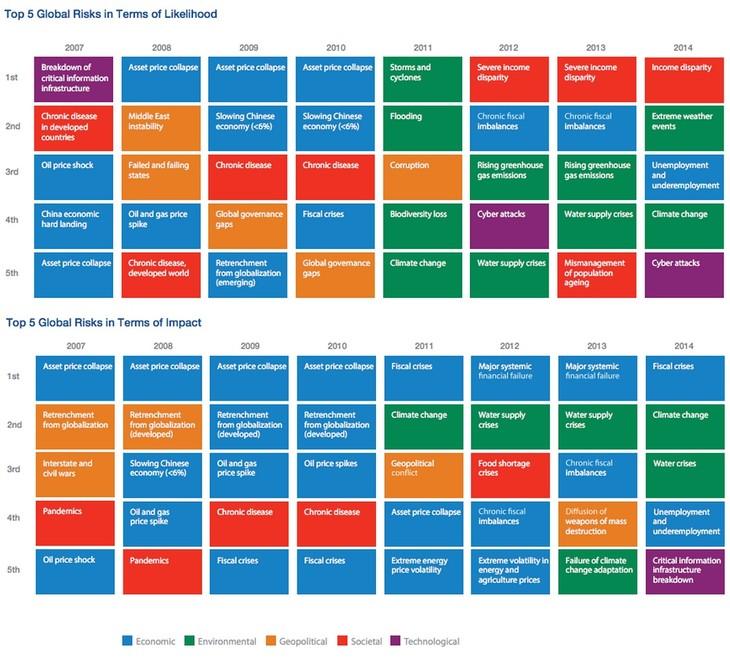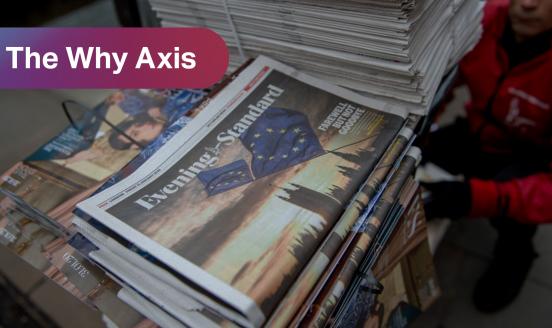Fact: The World still fears fiscal crises (and much else)
Last week, the World Economic Forum (WEF) published its Global Risk Report for 2014/15. The report is an exercise conducted by the WEF since 2006, but this year’s issue is particularly interesting because it adopts an historical perspective, offering very interesting insights on how the world has changed in respondents’ eyes and concerns.
The Global Competitiveness Report (GRR) assesses risks that are global in nature and have the potential to cause significant negative impact across entire countries and industries if they take place. A “global risk” is defined - for the purpose of the GRR’s exercise) - as “an occurrence that causes significant negative impact for several countries and industries over a time frame of up to 10 years”. 31 such risks are identified in the report and grouped under five categories – economic, environmental, geopolitical, societal and technological.
- Economic Risks include fiscal and liquidity crises, failure of a major financial mechanism or institution, oil-price shocks, chronic unemployment and failure of physical infrastructure on which economic activity depends.
- Environmental Risks encompass both natural disasters and man-made risks such as collapsing ecosystems, freshwater shortages, nuclear accidents and failure to mitigate or adapt to climate change.
- Geopolitical Risks cover politics, diplomacy, conflict, crime and global governance. These risks range from terrorism, disputes over resources and war to governance being undermined by corruption, organized crime and illicit trade.
- Societal Risks are intended to capture risks related to social stability – such as severe income disparities, food crises and dysfunctional cities – and public health, such as pandemics, antibiotic-resistant bacteria and the rising burden of chronic disease.
- Technological Risks covers major risks related to the centrality of information and communication technologies to individuals, businesses and governments (such as cyber attacks, infrastructure disruptions and data loss).
The objective of the report is to map the risks - by means of a survey - according to the level of concern they arouse, their likelihood and their potential impact. Additionally, the GRR also looks at the perception of interconnections between risks and the strength of their potential systematicity. The survey for this edition was conducted between October and November 2013 among respondents from business, government, academia and non-governmental and international organizations.
Note: From a list of 31 risks, survey respondents were asked to identify the five they are most concerned about.
Table 1 show the top-10 of risks for respondents in the GCR 204/15. Economic issues dominate the lists. The possibility of fiscal crises in key countries appears to be the concern that kept everybody awake at night, followed by post-recession structurally high unemployment or underemployment and concerns of severe income disparity. These concerns appear to be well-substantiated if one looks at the current situation in the euro area (even though the GCR unfortunately does not give a country or region breakdown of the responses).
Environmental concerns are also high-ranked, with failure to mitigate/adapt to climate change rank in the top-5 as well as water crises, whereas geopolitical risks are low in the ranking. This is most likely due to the timing of the survey (October-November 2013), which was conducted before the escalation in the Ukrainian crisis and the conflicts in the Middle East (which were in the top-5 back in 2008). Health issues - which disappeared from the list in 2011 - are also likely to come back next year, as the world struggles to manage the Ebola outbreak in Africa.
Figures below show the ranking of risks in terms of both likelihood and impact separately, for 2014 as well as for the previous 7 years. It has to be stressed that the exact definition of these risks has been changed by the WEF over the years, but the insights are many and interesting.
Economic risks are recurrently perceived as highly likely risks and as those having the strongest impact
Economic risks are recurrently perceived as highly likely risks and as those having the strongest impact. But it is very interesting to see how the economic concerns have changed over the years, following the developments in the global financial crisis first and of the euro sovereign crisis later. In 2008-10, the most dangerous economic risk in the perception of respondents was most naturally asset price collapse. In 2011, following the emergence of a sovereign crisis in Europe, fiscal crises climbed on top of the list. As the sovereign-banking troubles intensified during 2011/12, the risk of major systemic financial failures gained relevance. Now, as the emergency phase of the crisis is over but we are left to face its legacy of high debt burdens and economic slack, the focus has shifted to fiscal crises and structurally high unemployment as the high impact economic risks.
It is also interesting to see that the risk of growing income disparity has been ranking first in terms of likelihood since 2012 (well before the whole Piketty’s debate started) but does not seem to be considered a high-impact risk (even though the question asked explicitly clarifies that “impact” is “to be interpreted in a broad sense beyond just economic consequences”).
The risk of a major systemic financial failure appears less pressing than it was two years ago, but it still remains in the top-10, perhaps signalling that at the time the survey was conducted there was still significant uncertainty about the ongoing process of financial sector assessments in Europe and about banks’ possible capital needs in the near future (as we mentioned here).
Note: Global risks may not be strictly comparable across years, as definitions and the set of global risks have been revised with new issues having emerged in the 10-years horizon. For example, cyber attacks, income disparity and unemployment entered the set of global risks in 2012. Some global risks were reclassified: water supply crisis and income disparity were reclassified as environmental and societal risks, respectively, in 2014.

Another interesting part of the GCR exercise concerns the mapping of perceived interconnectedness across risks. Fiscal crises are perceived to be strongly connected with structural unemployment and underemployment, which in turn feed back social risks e.g. rising income inequality and political and social instability. The central node to the map of risk interconnectedness is represented by the risk of failure in global governance, from which a cascade of economic and socio-political risks would spill over.
The recent history of the Euro area proves perhaps better than any other case studies the existence of risk interconnectedness
The recent history of the Euro area proves perhaps better than any other case studies the existence of such interconnectedness. The financial turmoil of 2008-09 evolved into a sovereign-banking crisis with fiscal consequence, which in turn left behind a legacy of high unemployment and dissatisfaction vis à vis Europe, with the risk of increased social malaise and political instability. Governance played a great role in shaping the developments over the last five years and it will have to play a (perhaps even bigger) role in dealing with what will hopefully be a normalisation, over the next five years. In our recently published EU2DO list of memos for the new EU leadership, we try to offer some advice in view of this enormous challenge.



